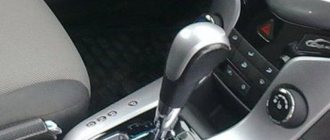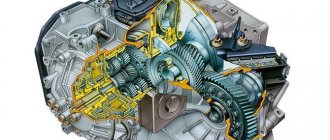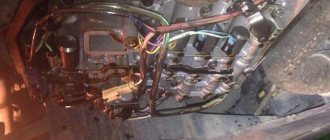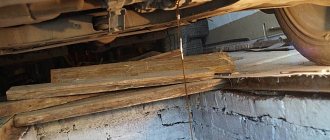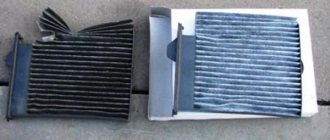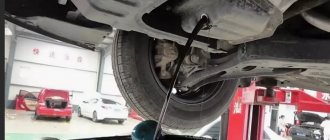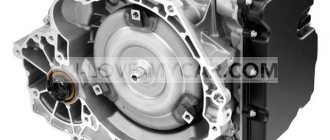01/25/2022 7,417 Transmission
Author: Victor
Lubrication of the internal components of the gearbox directly affects the operation of the unit. Therefore, car manufacturers recommend that car owners change the fluid on time and use only high-quality lubricant. In this article we will tell you how much oil is in a Nissan Tiida automatic transmission and how to change the working fluid in a garage.
[Hide]
Regulations
According to official data, the transmission fluid in a Nissan Tiida is replaced every 60 thousand kilometers. But practice shows that such an indicator can be considered only conditionally relevant, since the replacement period sometimes has to be shortened under the influence of climatic conditions. So, if in European countries with favorable road and weather conditions, you can still rely on 60 thousand kilometers, then in harsh realities it is better to reduce the regulations by half or one and a half times - for safety reasons. In addition, this will give you more confidence that the oil will not spoil before the allotted time. But this is quite possible if the car enthusiast constantly encounters the following factors:
- Temperature changes, sudden climate change (frost gives way to thaw, mud and slush on the roads, “salty winters”)
- Bad and dusty roads, frequent off-road driving, including on muddy ground after rain
In addition, the situation becomes even more complicated if the owner himself makes mistakes while driving the car. For example, he allows himself to deliberately jerk the car not only during such tests, but also constantly exceeds the speed, and thereby violates traffic rules. In addition, incorrect operation of the clutch and gearbox is possible, as a result of which the parts overheat and gradually fail, causing various breakdowns. But for the sake of fairness, it must be said that owners have to subject the car to high loads, including exceeding speed, etc. After all, they often have no other choice, given difficult weather and road factors. But it should be borne in mind that in such conditions the oil change period should be reduced to 40-45 thousand kilometers. In addition to more frequent oil changes, it is also strongly recommended to frequently monitor the volume and condition of consumables.
What oil to use in Nissan Tiida 1.6
Oil is poured into the engine of the Nissan Tiida 1 6 model according to the season and weather conditions.
Of course, you can argue about the choice endlessly, but we can highlight the product from Idemitsu; the excellent combination of Japanese oil and Japanese engine will provide the best lubrication conditions for your car’s engine.
- Idemitsu Euro Spec 5W40
As for the original oil, it is worth highlighting the universal product:
- NISSAN STRONG SM 5W-30
Article KLAM2-05304
The price per canister is about 2,200 rubles, the advantages are consistently high characteristics, because Quality control is carried out by the manufacturer himself. Among the shortcomings are fakes at every step.
We would like to highlight interesting thoughts regarding the choice of oil in the Nissan Tiida 1.6:
Selection of engine oil in Tiida (user scorpii – DRIVE2)
First, about Nissan's recommendations for engine oils for the HR16DE. According to the manual, Nissan recommends almost any oil for this engine.]
What do we see?
You can use almost any oil with viscosities 5w30, 5w40, 10w30, 10w40, 10w50, 15w40, 15w50, 20w40, 20w50; quality classes according to API: SL or SM, according to ILSAC: GF-3 or GF-4, according to ACEA: A1/B1, A3/B3, A3/B4, A5/B5, C2 or C3.
The preferred oil to use is 5w30, as evidenced by the entry in the manual, highlighted in bold text. What are the main functions of oil in our engine? Lubrication and protection of parts and friction units, their cooling, ensuring the operation of hydraulic systems. The oil should also prevent the formation and accumulation of deposits in the engine.
Do not forget that our cars are equipped with 2-stage TWC catalysts to ensure Euro-4(5). The requirements for motor oils when using such catalysts are low sulfated ash content (ACEA C2/C3). In truth, we have never come across situations where TWC failed on our cars due to the use of full-ash oils.
What the dealer pours, Nissan 5w40, has an ash content of 1.0, i.e. closer to medium ash (full ash ACEA A3 up to 1.6) i.e. one way or another, dealers take into account the presence of TWC with us.
Hydraulic properties will be better with thinner oils, i.e. 5w30 is preferable to 5w40, especially taking into account the timing chain drive with a hydraulic tensioner and the intake valve phase control clutch. Again, in my opinion, these components can easily withstand the warranty period even on dealer 5w40. I have not come across any cases of problems with these units on warranty vehicles.
It seems to me that dealers in Russia pour 5w40 in order to ensure a service interval of 15 thousand km - these oils are quite strong and resistant to oxidation. They don’t really care what happens to the chain or fluid coupling after the 100 thousand km warranty. Environmental issues (low ash, energy saving) in Russia are not so strictly posed that they start pouring ACEA C2 oils, for example. But the quality of the fuel can seriously affect the rapid demise of such oils and they will not withstand not only 15 thousand km, but much less. For Japanese HR15DE engines, 5w20 oils are recommended according to ilsac, many tubers with such engines use them quite successfully.
Taking into account all of the above and the problems that arise for different people on runs over 150 thousand km with chain stretching, crackling of the phase regulator with constant use of “thick” 5w40, we can draw the following conclusion: the optimal solution for HR16DE engines in the presence of TWC for year-round use will be the use of 5w30 motor oils ACEA A5/B5 - in principle, it was designed for them.
Replacement intervals in urban mode are no more than 6-7 thousand km (difficult conditions), highway - up to 8-9 thousand km For full-ash oils according to ACEA A3/B4, intervals can be increased to 10 thousand km The choice of a particular brand is strictly individual . As a budget and very good option, I can recommend Lukoil oils, which have been tested more than once at the oil club and have proven their worth.
When is an oil change required?
According to official regulations, changing the working fluid in Nissan Tiida 2008, 2010, 2011, 2013 and other years of production should be carried out after a mileage of 60 thousand kilometers. This rule applies regardless of the place where a particular car is assembled, be it Russia, Asia, Mexico or America. If the interval is not observed, this will lead to the fact that the working substance will lose its properties and will not be able to perform its functions. Difficulties will arise with shifting gears, the box will begin to vibrate, especially when starting in cold conditions. Extraneous noises and sounds may also appear, in some cases the liquid smells like burning.
First generation (2004 – 2014)
Four-speed automatic transmission (1.5L)
- Original gear oil used at the factory: semi-synthetic
- Recommended Transmission Fluid Specifications: Dexron III
- Lubricant volume in the gearbox: 7.7 l.
- Oil change interval: 50 thousand - 100 thousand km.
Four-speed automatic transmission (1.6L)
- Original gear oil used at the factory: semi-synthetic
- Recommended Transmission Fluid Specifications: Dexron III
- Lubricant volume in the gearbox: 7.7 l.
- Oil change interval: 50 thousand - 100 thousand km.
Practical advice on choosing oil in a Nissan Tiida automatic transmission
Many novice car enthusiasts who have recently purchased a vehicle ask me what kind of oil to fill in the automatic transmission. I advise you to use only the original fluid that is poured from the factory; in extreme cases, you can use an analogue, if available.
Original oils have the technical properties that are included in them by the manufacturer. They are designed to work exactly in those automatic transmissions into which they are filled. Engineers calculate the maximum viscosity, boiling and freezing temperatures at which they can work. If you pour counterfeit goods into an automatic transmission, the automatic transmission may go into emergency mode due to a mismatch of properties and a drop in pressure in the system.
Original oil
To change the oil in a Nissan Tiida automatic transmission, you need to use the following original oil:
- Idemitsu CVT Type N. Only this lubricant is suitable for the Nissan Tiida CVT gearbox.
Transmission fluid has technical properties that increase the smoothness of the transition to a particular gear while driving and during start-up. Idemitsu coats mechanical parts with a protective film that prevents rapid wear and tear. The grease does not foam and freezes only at record low temperatures.
Write in the comments, do you fill the Nissan Tiida Idemitsu CVT Type N automatic transmission?
Analogs
If your city does not have original oil for Nissan Tiida, you can purchase analogues. All lubricants with NS 2 approval are suitable.
These oils have excellent oxidation resistance and are thermally stable. Protects metal parts from wear and deposits.
Attention! Original oil for Nissan Tiida green.
Transmission oil change interval
A CVT transmission differs from an automatic transmission in that gear shifting occurs due to the movement of wedges and a belt. The latter must fit tightly to the drums so that switching occurs smoothly, without jerking. It shouldn't be weakened. Only high-quality and original oil can provide such a connection.
After thirty thousand kilometers, the lubricant becomes contaminated with wear products, for example, from a torque converter if some element in it is faulty. The turbine and pump wheel fall apart most quickly. Wear products enter the filter device and travel through the automatic transmission system. When they get under the belt, they tear it off the surface, and the gears do not shift smoothly.
In any case, the Tiida automatic transmission needs clean oil. For example, if the transmission fluid is dirty, overheating will occur more often. If you miss this point, further overheating will lead to failure of the valve body and electronic control unit. The car's automatic transmission may break down in the middle of the road.
My advice to you: change the oil partially after 30 thousand kilometers. And completely replace it after a run of sixty thousand kilometers.
Attention! If you recently bought a car, you may not change the transmission for 100,000 kilometers. Then the lubricant in the variator box is completely changed.
In case of the following problems, it is necessary to diagnose the Tiida automatic transmission and change the service:
- Pushes and kicks while changing gears or gears;
- The automatic transmission hums and vibrates when the car sits in traffic jams for a long time. This is especially noticeable in the summer;
- burning smell when viewing the transmission level.
Read
Complete and partial do-it-yourself oil change in an automatic transmission Toyota Corolla E150/E120 body
I also recommend changing the transmission fluid more often if you drive aggressively or use an automatic transmission under extreme operating conditions. Extreme conditions include:
- using a vehicle as a tractor;
- towing a car;
- trips in the cold season with temperatures below 30 degrees. Distributed in the northern regions.
In addition, how to monitor the regularity of oil changes in the CVT gearbox, you need to choose a high-quality lubricant that is suitable specifically for CVTs. Next, I will tell you which transmission fluid is best to use. In the meantime, answer the question what kind of lubricant you pour into an automatic transmission or a variator.
Checking the volume and condition of the oil
In a special hole in the automatic transmission there is a measuring device that is used to measure the fluid level. This procedure takes very little time and requires only attentiveness and consistency of actions from the driver. The optimal oil level is considered to be the volume that does not exceed the Max mark, and also does not fall below the Min mark on the dipstick. Any deviation from the specified norm may require adding oil, and in case of overflow, you will have to drain the excess liquid.
In addition, it is important to take into account the operating features and promptly check the condition of the oil. To do this, pull out the dipstick and carefully look at the oil print. For high mileage, it is recommended to drain a small amount of fluid and wait about an hour. During this time, sediment may appear at the bottom of the container, including metal shavings and mud deposits. In addition, other signs indicating that the oil is unsuitable include an unpleasant odor, as well as cloudiness and darkening of the liquid. In any of these cases, the oil change should be performed without any reservations or delays.
Leaks and problems
Leaks on Nissan Tiida engines are not common and occur mainly due to the lack of quality maintenance. But in any case, you need to look for the place where the oil is leaking individually.
But problems with fuel consumption and increased consumption occur regularly, especially on cars with mileage after 100 thousand kilometers. If the consumption from replacement to replacement is small, then you can try to select an oil that does not burn so badly. Or use the special LIQUI MOLY Pro-Line Motorspulung wash.
But if the engine begins to eat oil with great appetite, then most likely this indicates that the oil scraper rings are stuck. Decoking can solve this problem. Valve seals can also cause increased oil consumption. Over time, they become hard and “tan” and cease to perform their function. Replacing them should solve the problem of zhora.
Choosing oil for automatic transmission Nissan Tiida
To choose the appropriate consumables for the Nissan Tiida automatic, you need to focus on the oil characteristics recommended by the factory. At the same time, in this way you can protect the gearbox during the oil change process. So, with suitable parameters, everything is simple, because the manufacturer advises using only original oil called Nissan ATF Matic Fluid D. This product has ideal viscosity characteristics, is also well adapted for low temperatures and is designed for a long service life. The only negative is the high cost.
A more affordable oil is its analogue called Idemitsu ATF Type-J, which is practically not inferior in quality to the original.
As for the type of oil, you should choose only from two types - synthetic or semi-synthetic.
We carry out the replacement ourselves
The oil in the automatic transmission is designed to lubricate parts, protecting them from friction, and also to maintain the required temperature in the system. The operation of the entire system depends on its quality and level. Over time, transmission fluid loses its characteristics, because wear particles and used nozzles accumulate in it. If it is not changed in time, the automatic transmission may fail and cannot be repaired.
Nissan car manufacturers recommend changing the oil every 60 thousand mileage. If the first replacement is made after 60 thousand km, then the next ones will be 120 and 180, respectively. The frequency is affected by the operating conditions of the machine. If they are complex, then the lubricant is changed more often.
What kind of oil should I use?
It is recommended to pour Nissan ATF Matic Fluid J into automatic transmissions of the latest generation Nissan cars. This is a special development with the Slip Lock-up function. Characteristics:
- density – 865;
- kinematic viscosity at 40 degrees – 33.39;
- kinematic viscosity at 100 degrees – 7.39;
- viscosity index – 168;
- loses fluidity at a temperature of -50 degrees;
- flash point – 246.
Transmission fluid Nissan ATF Matic Fluid D
Nissan cars equipped with an electronic automatic transmission locking system use Nissan ATF Matic Fluid D. Characteristics:
- density – 868;
- kinematic viscosity at 40 degrees – 33.36;
- kinematic viscosity at 100 degrees – 7.45;
- viscosity index – 200;
- loses fluidity at a temperature of -50 degrees;
- flash point – 188.
Changing the oil in an automatic transmission for a Nissan Tiida car should be done with great precision. It is always better to fill the original one so that there are no problems when operating the machine. The volume of liquid to be filled is 7.7 liters.
If the mileage of a Nissan Tiida car is up to 30 thousand, you can do a partial lubricant change. In the future, it is better to completely change the ATF every 10 thousand kilometers; it is advisable to do this in specialized services. If the transmission fluid is not changed on time, wear will increase and the load on the parts when they come into contact with each other will increase. This may cause engine damage. The working fluid should be transparent, not have a burnt odor, and be easily absorbed by a paper napkin.
Oil change options
Changing the lubricant in a Nissan Tiida automatic transmission is possible in two options: partial and complete. With a partial replacement, approximately half of the total volume changes, because It is impossible to drain all the fluid; it remains in the clutch housing, torque converter, and also in some other components of the system. This may affect the further operation of the transmission.
To make a complete replacement, you need special equipment to pump out all the transmission fluid from the system. Then the system is flushed and new oil is added. It is advisable to perform this procedure in a specialized car service center.
Special car service equipment
For a partial replacement, 5 liters of Nissan ATF Matic Fluid D will be enough. Its frequency is 30 thousand kilometers, during which time the used oil leaves the system. A complete replacement requires 10 liters of lubricant. You can replace the filter, but this is not necessary.
What will you need?
For the procedure you will need:
- containers for draining waste liquid (depending on what kind of replacement will be: partial or complete);
- key to 19;
- new oil, preferably original Nissan ATF Matic Fluid D;
- gloves;
- funnel;
- jack or inspection hole;
- gasket on the pan when replacing the filter;
- new filter.
Loading …
Stages
The partial oil change process consists of the following steps:
- The car is placed on a viewing hole or raised with a jack.
- If you change the filter, you need to unscrew the pan under which the filter is located. In case of partial replacement, the filter is usually not changed.
- Next, a container is placed under the drain hole into which the waste liquid will be drained. Use a 19 key to slightly unscrew the plug on the drain hole. Then you can unscrew it completely by hand. The grease may run on your hands, so it is better to wear gloves before working. Draining waste fluid
- When all the liquid has flowed out, it is necessary to measure its volume. You can pour it into a measuring container or container whose volume is known. This must be done to know how much new oil will need to be filled.
- After all the liquid has drained, the plug must be screwed into place.
- At the next stage, the dipstick is removed from the filler hole, a funnel is inserted, and as much new transmission fluid is poured in as was drained. ATF filling procedure
- The dipstick is inserted back. Next, start the engine and let it run for 5 minutes.
- Now shift all gears sequentially, maintaining an interval of several seconds between shifts.
- After finishing checking the gear shift, you should check the oil level using the dipstick. If necessary, add ATF.
If you bought a used car, then it makes no sense to completely change the ATF. It is enough to partially change the fluid, unscrew the pan, and clean it of wear particles. In this case, the gasket on the pan should be replaced. The filter does not need to be changed, you can simply wash it.
If you decide to completely replace the lubricant in the automatic transmission, it is better to contact a service center with specialists who will carry out the procedure using special equipment.
What tools will you need?
To change the oil in a Nissan Tiida automatic transmission, you need the following tools:
| Name | Note |
| Key | “at 19” |
| Jack | Not required if there is an inspection hole or lift |
| Funnel or watering can | For ease of filling with new lubricant |
| Knife | To clean the old pan gasket |
Prepare in advance:
- containers for processing;
- gloves;
- pallet gasket (if you do dismantling);
- new filter;
- rags.
Checking the transmission fluid level
It is necessary to periodically check the lubricant level in the Nissan Tiida automatic transmission. Use the instructions below:
- Secure the vehicle on a level surface using the handbrake.
- Start the power plant.
- Alternately move the selector to different positions. Stop in neutral or park.
- Remove the dipstick.
- Wipe the meter from any grease residue.
- Return the dipstick to its place. Screw it all the way in.
- Remove the dipstick. The normal oil level depends on the temperature of the box. When it’s cold, it should be in the area of the “Cold” zone; when it’s hot, it should be about flooded. When flushing, 12-14 liters of oil are required.
How much to fill
At the end of the article, we will determine the optimal volume of oil to be poured into the Nissan Tiida automatic transmission. So, the 4-speed automatic transmission JF404E requires 7.5 liters of consumables. The specified volume is filled after draining the old oil, as well as cleaning the gearbox from various deposits, including metal shavings. Cleaning can be done using a flushing agent that is circulated throughout the automatic transmission with the engine running. Then the used flushing is removed from the box, after which 7.5 liters of liquid are poured. Its level is adjusted to normal using a dipstick.
When to change the oil
The oil in the Nissan Tiida automatic transmission, according to official recommendations, is replaced every 60 thousand kilometers - at the first stage. Each subsequent replacement is carried out at the 120th and then at the 180th thousand. The frequency of replacement depends on climatic factors and other operating features - road conditions, driving style, etc. The more complex and severe the conditions, the more often replacement is required.
The optimal frequency of oil changes in a Nissan Tiida automatic transmission in Russian conditions is 30 thousand kilometers.
Customer Reviews
Union Motors technical centers have a 5-star Yandex user rating since 2022!
We thank all Union Motors clients for their high rating! Thank you for being with us!
Online ratings of technical centers:
Union Motors Berezhkovskaya
Union Motors Medvedkovo
291017 Well done guys!!!
... I signed up for chassis diagnostics, the silent blocks of the front arms and the front and rear stabilizer bushings were torn, it was already late and it was decided to reschedule the next day, the inspection master found a convenient time for me. The next day I came to replace worn out parts...
Read the full review of Union Motors · Comments 1 · Like
Read all reviews
Complete replacement of transmission fluid in automatic transmission
A complete change of transmission fluid in a Nissan Tiida is identical to a partial one, with the exception of the last steps. After you pour oil into the machine, your actions will be as follows:
- Remove the return hose from the cooling system.
- Extend it and insert the free end into a five-liter bottle.
- Call your partner and ask him to start the Tiida engine.
- Black waste will pour into the bottle. Wait until the liter is drained.
- Stop the engine and add as much as drained.
- Start the engine again and repeat the procedure until clear liquid flows out.
Add more, reinstall the hose and start the car. Warm up the automatic transmission and drive the car. Check the level and top up if necessary.
Write in the comments whether you have already done a complete change of transmission fluid in a Tiida automatic transmission or have used the services of service centers?
Checking the level
This type of automatic transmission has a dipstick to check the oil volume in the automatic transmission. I advise you to check it once every 10 thousand kilometers. It is during this time that the oil volume in the automatic transmission decreases greatly.
Verification procedure steps:
- Warm up the Nissan Tiida automatic transmission.
- Press the brake pedal and move the gear selector knob through all the CVT gears.
- Then place the Nissan Tiida on a flat surface.
- Stop the engine and open the hood.
- Unscrew the plug with the dipstick and wipe the tip with a lint-free cloth.
- Screw the dipstick 180 degrees back into the hole.
- Take it out again and look at the grease level on the dipstick. If it corresponds to the “Max” risk, then you can continue driving the car without risking the health of the automatic transmission. If it is less, then you should add transmission fluid.
Read
Nissan automatic transmission repair
At the same time as checking the level, pay attention to the quality of the lubricant and color. Pay special attention to this on older cars, where the oil can become dirty after every 20 thousand kilometers driven.
If you see a black spot on the rag, with a burning smell or metallic glitter, then immediately change the lubricant.
Functions of automatic transmission oil in a car
The main function of transmission fluid is to lubricate the surfaces of parts to reduce friction between them. In addition, the oil controls the temperature in the engine.
The main tasks of gear oil include:
- reducing the friction force between the surfaces of the nodes;
- protection of parts from corrosion;
- temperature regulation and system cooling.
After a certain time or mileage, the lubricant gradually loses its properties, which indicates the need to replace it with a new one.
You can understand that the transmission fluid requires replacement by the following signs:
- increased fuel consumption;
- uncharacteristic sounds from the gearbox;
- problems when starting the engine for the first time;
- poor response of the selector to driver movements;
- violation of the smoothness of gear changes;
- reduction in vehicle dynamics.
Changing the automatic transmission oil in a Nissan Tiida is necessary in order to eliminate the negative impact of the lubricant on the components of the unit and extend the life of the machine.
What kind of oil should I use?
The Tiida automatic transmission is filled with proprietary transmission fluid ATF Matic Fluid D. It is used on cars that are equipped with an electronic transmission locking system.
On cars manufactured after 2011, the original Nissan ATF Matic Fluid J oil is used. It is permitted to use this lubricant instead of ATF Matic Fluid D. There is no reverse interchangeability. Fluid J transmission fluid has less foaming and a higher flash point, which allows it to provide better protection against friction when driving in difficult conditions.
| Characteristic | Nissan ATF Matic Fluid D | Nissan ATF Matic Fluid J |
| Lubricant density | 868 | 865 |
| Kinematic viscosity at 100°C | 7,45 | 7,39 |
| Pour point | 50 | 50 |
| Kinematic viscosity at 40°C | 33,36 | 33,39 |
| Flash point | 188 | 246 |
| Oil viscosity index | 200 | 168 |
| Price (in rubles) | 2500-3000 | 2700-3100 |
Tiida automatic transmission uses Nissan CVT Fluid NS-2 oil. It is poured into the variator. Its use in a classic automatic transmission with a torque converter is prohibited.



